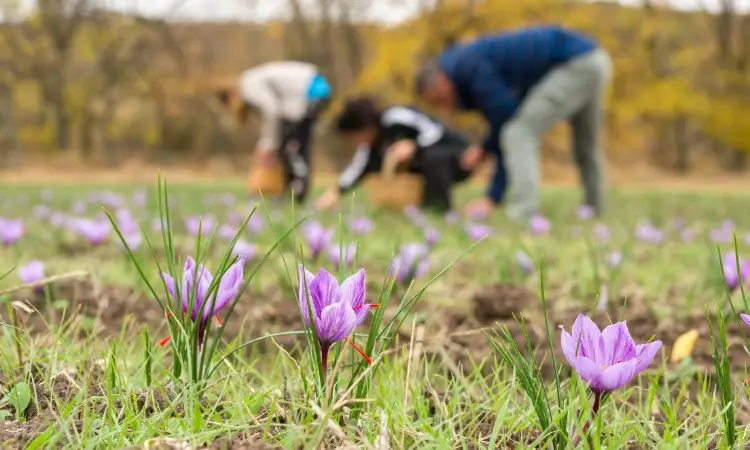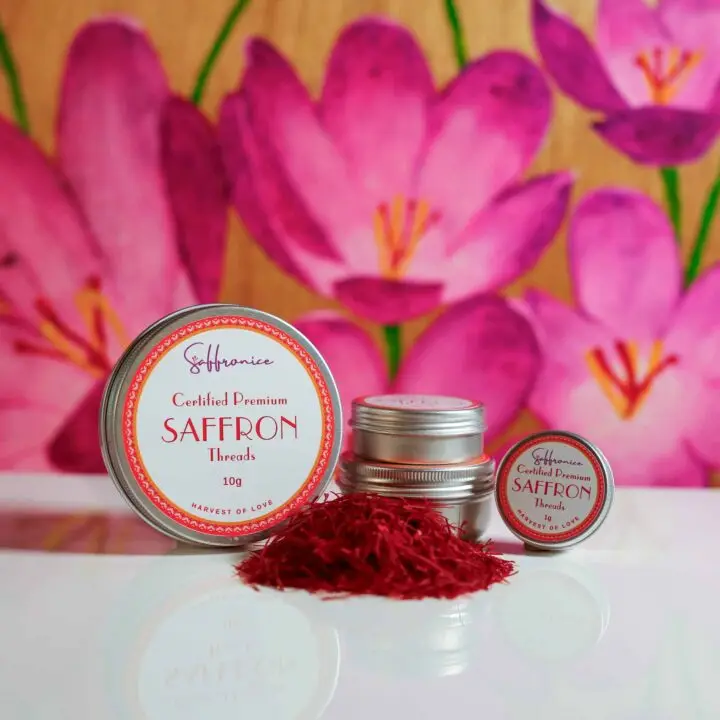Are you fascinated by saffron, the world’s most valuable spice? This precious crop combines rich cultural history with exceptional market value, making it increasingly appealing for environmentally conscious farmers. But how do you grow saffron sustainably while maintaining profitability? This comprehensive guide reveals the secrets of modern, eco-friendly saffron farming that benefits both the planet and your bottom line.
Saffron comes from the Crocus sativus plant, renowned for its vibrant crimson threads, distinctive aroma, and remarkable health benefits. With Iran producing 90% of the world’s saffron supply, opportunities exist for new farmers to establish themselves in this lucrative market. By implementing sustainable practices, water conservation techniques, and organic cultivation methods, you can unlock saffron’s full potential while building a thriving, environmentally responsible agricultural business.
📌 Quick Answer: Sustainable saffron farming combines organic cultivation methods (no synthetic pesticides/fertilizers), water conservation through drip irrigation (reducing usage by 90%), integrated pest management using natural predators, proper corm rotation every 3-5 years, and eco-friendly post-harvest processing. These practices reduce environmental impact while maintaining high quality and profitability, addressing climate change concerns and water scarcity issues.
Key Takeaways
- Sustainable saffron farming protects the environment while ensuring premium quality and profitability.
- Organic methods eliminate synthetic chemicals, improving soil health and product purity.y
- Water conservation techniques reduce consumption by up to 90% compared to traditional methods.ds.
- Integrated pest management maintains ecological balance without harmful pesticides.
- Proper harvesting and processing preserve quality while minimizing waste
- Market demand for sustainably grown saffron continues to increase globally

Understanding Saffron’s Rich History and Market Value
Saffron’s journey through human history spans millennia, establishing it as one of civilization’s most treasured commodities. Understanding this context helps modern farmers appreciate the crop’s significance and market positioning.
Ancient Origins and Cultural Significance
Saffron cultivation traces back to the 7th century BC in Assyria, derived from wild Crocus cartwrightianus. Ancient civilizations valued saffron for culinary enhancement, medicinal applications, cosmetic uses, and even as a luxury dye. Greek cultivation began around 1700 BCE, with expansion into Spain by the 10th century CE.
Historical records reveal saffron’s extraordinary value—the 15th-century royal house of Navarre paid eight times more for saffron than pepper. Royalty and elite classes prized saffron for its sedative, expectorant, and reputed aphrodisiac properties, cementing its status as a symbol of wealth and refinement.
Chef’s Professional Tip: Working with saffron in professional kitchens has taught me that historically cultivated varieties often possess more complex flavor profiles than modern mass-produced alternatives. Traditional cultivation regions like Kashmir, Iran, and Spain produce saffron with subtle terroir characteristics—similar to wine—that discerning chefs can detect. Sustainable farming practices tend to preserve these nuanced qualities better than industrial methods.
Current Market Dynamics and Pricing
Today’s saffron market reflects the spice’s labor-intensive nature and limited production areas. Producing one kilogram of dried saffron requires harvesting 70,000-200,000 hand-picked flowers, demanding approximately 370-470 hours of labor. This intensive process justifies retail prices averaging $5 per gram ($2,270 per pound) in the United States, with premium grades commanding significantly more.
Global Production Overview:
| Country | Annual Production (Tonnes) | Market Share |
|---|---|---|
| Iran | 300 | 90% |
| India | 3.83 | 5% |
| Spain | 3 | 1.5% |
| Greece | 7 | 2% |
| Morocco | 3 | 1.5% |
Iran’s dominance stems from ideal growing conditions and established infrastructure. However, increasing labor costs have impacted production in regions like Jammu and Kashmir, India, creating opportunities for new producers employing efficient, sustainable methods.
Food Scientist’s Note: Saffron’s market value correlates directly with its chemical composition—specifically crocin (color), picrocrocin (flavor), and safranal (aroma). Sustainable farming practices that optimize soil health and minimize plant stress typically produce saffron with higher concentrations of these compounds, justifying premium pricing and superior market positioning.
Essential Requirements for Saffron Cultivation
Understanding saffron cultivation requirements forms the foundation for successful, sustainable farming. Crocus sativus demands specific conditions that, when properly managed, yield exceptional results.
Botanical Characteristics
Crocus sativus exhibits unique characteristics distinguishing it from other crops:
- Fall Flowering: Unlike most plants, saffron blooms in autumn (October-November)
- Sterile Hybrid: Cannot reproduce through seeds; propagation occurs exclusively via corm division
- Limited Stigmas: Each flower produces only three valuable crimson stigmas
- Perennial Nature: Corms remain productive for 3-5 years before requiring redistribution
- Underground Storage: Corms survive harsh conditions, dormant underground during summer
Growing Zone Requirements
Saffron thrives in USDA hardiness zones 6-9, though successful cultivation extends to zones 5-10 with proper management. The plant requires:
Temperature Ranges:
- Summer dormancy: 25-35°C (hot, dry conditions)
- Autumn flowering: 15-20°C (cool, moderate conditions)
- Winter growth: 5-15°C (cold, wet conditions)
- Spring maturation: 10-20°C (warming, drying conditions)
Light Requirements: Minimum 6 hours daily direct sunlight, optimal 8-12 hours
Chill Hours: 1,000-1,500 hours between 0-10 °C, triggering proper flowering
Understanding saffron farming climate requirements helps farmers assess site suitability and plan necessary adaptations.
Soil and Drainage Fundamentals
Saffron demands well-drained soil, oil preventing waterlogging—the leading cause of crop failure. Ideal soil characteristics include:
- Texture: Sandy loam or loamy soil with excellent drainage
- pH Range: 6.0-8.0 (optimal: 7.0-7.5)
- Organic Matter: 2-4% supporting nutrient availability
- Depth: Minimum 20cm, allowing proper root development
- Structure: Loose, friable texture facilitating corm expansion
Poor drainage causes immediate corm rot and devastating crop loss, making soil preparation the most critical pre-planting investment.
Selecting and Preparing the Growing Site
Proper site selection and preparation prevent common saffron growing challenges and establish conditions for long-term success.
Comprehensive Soil Preparation
Begin soil preparation 3-4 months before planting:
Step 1: Site Assessment
- Test drainage by digging 30cm holes, filling with water, and monitoring drainage time (should disappear within 24 hours)
- Conduct soil testing, determining pH, nutrient levels, and organic matter content.
- Assess sun exposure, ensuring g minimum of 6 hours of direct sunlight daily.y
Step 2: Soil Improvement
- Deep cultivation to 30-40cm depth, breaking compacted layers
- Incorporate well-composted organic matter (10-15 tons per hectare), improving structure and fertility
- Add coarse sand (20-30% by volume) to heavy clay soil, enhancing drainage
- Adjust pH using agricultural lime (raising) or elemental sulfur (lowering)
Step 3: Raised Bed Construction
- Build raised beds 20-30cm high, ensuring superior drainage
- Create beds 1-1.5m wide for easy access and management
- Space beds allowing equipment passage and air circulation
Step 4: Final Preparation
- Apply rock phosphate or bone meal (50-80 kg P₂O₅ per hectare)
- Allow soil to settle 6-8 weeks before planting
- Install rodent barriers (hardware cloth) if pest pressure exists
Irrigation Systems Setup
Modern saffron irrigation needs are best met through efficient systems, minimizing water waste while optimizing plant health.
Drip Irrigation Installation:
Drip irrigation represents the optimal choice for sustainable saffron farming, reducing water consumption 40-50% compared to traditional methods while improving crop performance.
System Components:
- The main supply line distributing water from the source
- Sub-main lines servicing field sections
- Lateral drip lines with emitters spaced 20-30cm apart
- Pressure regulators maintaining 1.0-1.5 bar
- Filters preventing emitter clogging
- Automated timer controlling irrigation schedules
Installation Guidelines:
- Position drip lines 5-10cm from saffron rows
- Use inline emitters delivering 1-2 liters per hour
- Install pressure-compensating emitters, ensuring uniform distribution
- Connect to the rain sensor, preventing unnecessary watering
- Integrate fertigation capabilities for precise nutrient delivery
Quality saffron farm equipment pays dividends through improved efficiency and reduced labor requirements.
Climate Adaptation Strategies
Successful sustainable farming requires adapting to local climate conditions:
Hot Climate Adaptations:
- Install 30-40% shade cloth during extreme heat waves
- Use reflective mulch to reduce soil temperature
- Increase irrigation frequency during flowering
- Select heat-tolerant varieties
Cold Climate Adaptations:
- Apply heavy mulch (10-15, cm) protecting corms from severe frost
- Use row covers during unexpected cold snaps
- Select cold-hardy varieties tolerating -20°C
- Consider hoop houses or greenhouses in extreme regions
Humid Climate Adaptations:
- Ensure exceptional drainage, preventing fungal diseases
- Increase plant spacing, improving air circulation
- Avoid overhead irrigation, keeping foliage dry
- Apply preventative organic fungicides (copper, sulfur)
Planting and Managing Crocus Sativus Corms
Proper corm management establishes productive saffron fields, generating returns for multiple years.
Optimal Planting Timing
Northern Hemisphere: Late July through September (6-8 weeks before autumn rains)
Southern Hemisphere: Late January through March (adjust for local conditions)
Timing Considerations:
- Plant when the soil temperature reaches 20-25°C at planting depth
- Early planting (July-August) establishes strong root systems before flowering
- Late planting (September) may reduce first-year yields, but it still succeeds
- Avoid planting during extreme heat or drought conditions
Corm Selection and Handling
Quality Standards:
- Select large, healthy corms weighing 10-15g minimum (larger produce more flowers)
- Inspect for disease, damage, or soft spots, indicating problems
- Source certified disease-free planting stock from reputable suppliers
- Avoid corms smaller than 8g (produce fewer flowers and weak plants)
Pre-Planting Treatment:
- Optional: Soak corms in water for 12-24 hours before planting, improving hydration
- Apply organic fungicide treatment to prevent disease
- Handle gently, avoiding bruising or damage
Chef’s Professional Tip: The corn size directly impacts final product quality. Large corms (12-15g) produce more flowers with larger, more aromatic stigmas. When sourcing saffron for professional kitchens, I specifically seek suppliers growing from large corms—the quality difference is immediately apparent in both aroma intensity and color strength.
Planting Technique
Spacing and Depth:
- Plant corms 10-15cm apart within rows
- Space rows 20-30cm apart, allowing access and air circulation
- Dig holes or trenches 10-15cm deep
- Orientthe corms with the pointed growing tip upward
- Cover with 8-10cm of soil above the corm top
Post-Planting Care:
- Water generously immediately after planting, settling soil around corms
- Apply a 5-7cm mulch layer (straw, leaves), conserving moisture and moderating temperature
- Monitor for emergence (typically 4-6 weeks after planting)
- Reduce watering once leaves emerge, allowing soil to partially dry between irrigations
Ongoing Corm Management
Annual Maintenance:
- Remove yellowing foliage after it dies back naturally (spring)
- Apply balanced organic fertilizer (late winter/early spring)
- Monitor for pest activity (rodents, insects)
- Maintain a mulch layer throughout the growing season
Corm Multiplication:
- Mother corms divide annually, producing daughter corms
- Productivity peaks in years 2-4 after planting
- After 3-5 years, corms become overcrowded, reducing flower production
- Lift, divide, and replant corms every 3-5 years, maintaining productivity
Sustainable Saffron Farming Practices
Implementing sustainable methods distinguishes organic saffron farming from conventional approaches, benefiting both the environment and product quality.
Organic Cultivation Methods
Organic saffron farming eliminates synthetic inputs while building soil health and supporting biodiversity.
Natural Fertilization:
Compost Application: Incorporate 10-15 tons well-aged compost per hectare annually, providing slow-release nutrients and improving soil structure
Green Manures: Plant nitrogen-fixing cover crops (clover, vetch) during saffron dormancy, tilling them in before the flowering season
Rock Minerals: Apply rock phosphate, greensand, or kelp meal, supplying trace minerals and supporting plant health
Compost Tea: Foliar applications of aerated compost tea boost plant immunity and nutrient uptake
Soil Health Management:
- Avoid tilling excessively, preserving soil structure and microbial communities
- Maintain organic matter levels through annual compost additions
- Practice crop rotation where possible (though saffron occupies land for 3-5 years)
- Monitor soil biological activity, indicating healthy ecosystem function
Food Scientist’s Note: Research demonstrates that organically grown saffron contains higher concentrations of bioactive compounds compared to conventionally grown alternatives. The absence of synthetic inputs forces plants to produce more secondary metabolites—including crocin, picrocrocin, and safranal—as natural defense mechanisms. This biological stress response actually enhances saffron quality and medicinal properties.
Water Conservation Techniques
Water scarcity represents a growing global concern, making conservation essential for sustainable agriculture.
Efficient Irrigation Strategies:
Drip Irrigation Benefits:
- Reduces water consumption by 40-50% versus flood irrigation
- Eliminates evaporation losses from the soil surface
- Prevents foliar wetting, reducing disease pressure
- Allows precise timing and volume control
- Enables fertigation, reducing fertilizer waste
Mulching Applications:
- Apply 5-10 coats of organic mulch (straw, wood chips, leaves) around plants
- Reduces evaporation by 30-40%
- Moderates soil temperature extremes
- Suppresses weeds competing for water
- Adds organic matter as it decomposes
Rainwater Harvesting:
- Install collection systems capturing rainfall from buildings
- Store water in tanks or reservoirs for irrigation use
- Reduces dependence on groundwater or municipal supplies
- Provides chemical-free water ideal for organic production
Soil Moisture Monitoring:
- Use tensiometers or electronic sensors tracking soil moisture
- Irrigate based on actual plant needs rather than fixed schedules
- Prevent overwatering that wastes water and damages corms
- Maintain optimal moisture levels throughout the growing season
Integrated Pest Management Strategies
Sustainable pest control maintains ecological balance while protecting crops from damage.
Cultural Control Methods:
Field Sanitation: Remove plant debris and weeds harboring pests
Crop Rotation: Rotate with non-related crops where feasible, breaking pest cycles
Resistant Varieties: Select saffron strains showing natural pest resistance
Optimal Timing: Plant at times minimizing pest pressure
Physical Barriers:
- Install underground wire mesh preventing rodent access to corms
- Use bird netting during flowering to protect flowers from bird damage
- Create physical barriers around beds, deterring rabbits and hares
Biological Control:
Beneficial Insects: Encourage predatory insects (ladybugs, lacewings, ground beetles) consuming pest species
Natural Predators: Support raptor populations (owls, hawks), controlling rodent numbers naturally
Companion Planting: Grow aromatic herbs (garlic, marigold,s) repelling certain pests
Microbial Controls: Apply Bacillus thuringiensis (Bt) to control caterpillar pests
Organic Pesticides (Last Resort):
- Neem oil: Controls various insects while remaining safe for beneficial organisms
- Diatomaceous earth: Physical barrier against crawling insects
- Insecticidal soaps: Controls soft-bodied pests
- Copper fungicides prevent fungal diseases organically

Harvesting and Post-Harvest Processing
Expert saffron harvesting methods preserve quality while maximizing yield from each precious flower.
Optimal Harvest Timing
Saffron flowering typically occurs over 2-3 weeks in October-November (Northern Hemisphere) or April-May (Southern Hemisphere).
Daily Harvest Schedule:
- Begin at dawn when flowers are closed or barely opening
- Complete harvest by mid-morning before full opening
- Pick flowers daily throughout the blooming period
- Handle flowers gently, preventing stigma damage
Flower Selection:
- Harvest flowers on their second day for optimal quality
- Pick flowers with closed or just-opening petals
- Avoid overripe flowers with fully opened petals
- Select vibrant, healthy-looking flowers only
Stigma Extraction Process
The delicate stigma removal process requires care and attention:
Immediate Processing:
- Process flowers within hours of harvest ,maintaining quality
- Work is n clean, well-ventilated space away from direct sunlight
- Gently pull back petals, exposing stigmas
- Carefully pluck or cut the three crimson stigmas plus a small portion of the yellow style
- Discard remaining flower parts (or compost them)
Quality Preservation:
- Minimize handling time between harvest and drying
- Keep stigmas cool and away from direct light
- Process in batches, maintaining organization
- Avoid crushing or bruising delicate stigmas
Labor Efficiency:
- Organize efficient workstations for processing teams
- Train workers in proper technique, ensuring consistency
- Establish quality control checks throughout processing
- Document flower counts and stigma weights, tracking productivity
Saffron Drying Methods
Proper drying preserves saffron quality and prevents degradation. Learn more about optimal saffron storage methods for long-term quality maintenance.
Food Dehydrator Method (Recommended):
- Spread stigmasa in a isinglelayer on dehydrator trays
- Set temperature to 45-50°C (115-120°F)
- Dry for 30-60 minutes until threads are crisp
- Cool completely before storing
- Advantages: Consistent results, fast drying, quality preservation
Air Drying Method:
- Spread stigmas on mesh screens in a well-ventilated, dark room
- Maintain room temperature 20-25°C with low humidity
- Dry for 2-3 days until crisp
- Turn stigmas occasionally, ensuring even drying
- Advantages: No equipment needed, traditional method
Avoid These Mistakes:
- Never dry in direct sunlight (degrades color and aroma)
- Don’t use excessive heat above 50°C (destroys bioactive compounds)
- Avoid humid environments (promotes mold growth)
- Don’t rush the drying process (affects quality)
Quality Control and Storage Methods
Maintaining saffron quality standards ensures product value and customer satisfaction.
Saffron Grading Systems
Professional saffron grading systems evaluate multiple quality parameters:
ISO 3632 Standard Categories:
Category I (Superior Grade):
- Crocin (color): >190
- Picrocrocin (flavor): 70-100
- Safranal (aroma): 20-50
- Moisture: <12%
Category II (High Quality):
- Crocin: 150-190
- Picrocin: 70-100
- Safranal: 20-50
- Moisture: <12%
Category III (Good Quality):
- Crocin: 110-150
- Picrocin: 70-100
- Safranal: 20-50
- Moisture: <12%
Visual Quality Indicators:
- Deep crimson-red color without yellow styles
- Intact threads without broken fragments
- Uniform size and appearance
- Intense aromatic fragrance
- Dry, crisp texture
Proper Storage Techniques
Correct storage preserves saffron quality for extended periods:
Container Selection:
- Use airtight glass jars or food-grade metal containers
- Avoid plastic containers (may transfer flavors or allow air penetration)
- Choose dark-colored containers to block light exposure
- Ensure containers are completely clean and dry
Storage Conditions:
- Temperature: 5-15°C (refrigeration optional but beneficial)
- Humidity: Below 60% relative humidity
- Light: Complete darkness prevents photodegradation
- Location: Away from strong-smelling substances
Storage Duration:
- Optimal quality: First 12 months
- Acceptable quality: Up to 24 months
- Gradual decline: Beyond 2 years
- Regular checks: Monitor for moisture, mold, or aroma loss
Chef’s Professional Tip: In professional kitchens, we store premium saffron in amber glass jars within a cool, dark cupboard. Before using, we toast threads lightly in a dry pan for 5-10 seconds—this activates aromatics and makes threads easier to crumble. Never buy pre-powdered saffron; whole threads maintain quality significantly longer and prove authenticity.
Marketing and Distribution Strategies
Building a successful saffron business requires effective marketing and distribution approaches that emphasize sustainability and quality. Understanding saffron farming profitability helps optimize business strategies.
Brand Development
Sustainability Story:
- Highlight organic certification and eco-friendly practices
- Document water conservation achievements
- Showcase biodiversity support and soil health initiatives
- Share farmer stories and cultivation philosophy
- Emphasize a quality over quantity approach
Visual Identity:
- Develop professional packaging reflecting premium quality.
- Create a compelling brand narrative around sustainability
- Use high-quality photography showing the cultivation process
- Design educational materials explaining saffron benefits and uses
Digital Marketing Approaches
Website and E-Commerce:
- Build a professional website with online ordering capabilities
- Optimize for search engines targeting saffron-related keywords
- Create educational content about sustainable saffron farming
- Share recipes, usage tips, and health benefit information
- Collect customer testimonials and reviews
Social Media Strategy:
- Document farming activities throughout the growing season
- Share behind-the-scenes harvest and processing content
- Engage with cooking and sustainability communities
- Partner with chefs and food bloggers for exposure
- Use Instagram and Pinterest for visual storytelling
Content Marketing:
- Publish blog articles about sustainable agriculture
- Create video content showing farming practices
- Develop downloadable guides and recipe collections
- Share seasonal updates and availability information
Distribution Channels
Direct-to-Consumer:
- Online sales through website (highest profit margins)
- Farmers’ markets and agricultural festivals
- Community-supported agriculture (CSA) programs
- Mail-order subscriptions for regular customers
Wholesale Partnerships:
- Specialty food stores and gourmet shops
- High-end restaurants and professional kitchens
- Natural food cooperatives
- Spice retailers and culinary boutiques
Value-Added Products:
- Saffron-infused honey, salt, or oils
- Blended spice mixes featuring saffron
- Beauty and skincare products containing saffron
- Gift sets and specialty packaging
Export Opportunities:
- Target markets valuing sustainably grown saffron
- Research import regulations for target countries
- Consider wholesale opportunities for bulk sales
- Obtain necessary certifications (organic, fair trade)
Frequently Asked Questions
What makes saffron farming sustainable?
Sustainable saffron farming incorporates organic cultivation methods, eliminating synthetic pesticides and fertilizers, water conservation techniques reducing consumption by 40-90%, integrated pest management using biological controls rather than chemicals, soil health building through composting and cover cropping, and renewable energy use for processing and storage. These practices minimize environmental impact while maintaining product quality and economic viability.
How much water does sustainable saffron farming save?
Drip irrigation systems reduce water consumption by 40-50% compared to traditional flood irrigation. Combined with mulching (reducing evaporation by 30-40%) and rainwater harvesting, total water savings can reach 60-90% compared to conventional methods. Saffron requires 300-600mm annually when properly managed, making it relatively drought-tolerant compared to manl crops, especially with efficient irrigation systems.
Is organic saffron more profitable than conventional?
Organic saffron typically commands 20-30% price premiums due to growing consumer demand for sustainably produced products. While organic methods may have higher initial labor costs, reduced input expenses (no synthetic fertilizers/pesticides), and premium pricing often result in better profit margins. Additionally, organic saffron maintains quality longer and develops stronger customer loyalty, supporting long-term business sustainability.
How long does it take to establish a sustainable saffron farm?
Site preparation requires 3-4 months before planting. First-year yields are typically modest as corms establish. Years 2-4 represent peak productivity before corm renewal becomes necessary. Full return on investment typically occurs within 3-4 years. Sustainable practices may require slightly longer establishment but provide better long-term resilience and productivity compared to conventional methods.
What pests threaten saffron crops, and how are they controlled sustainably?
Primary pests include rodents (mice, voles) eating corms, birds damaging flowers, and occasional insect pests (wireworms, cutworms). Sustainable control methods include physical barriers (underground mesh, bird netting), beneficial insects (ladybugs, ground beetles), natural predators (raptors for rodents), companion planting (aromatic herbs repelling pests), and organic pesticides as s last resort (neem oil, Bt, diatomaceous earth). Integrated pest management maintains ecological balance while protecting crops.
Can saffron farming help address climate change?
Yes, sustainable saffron farming contributes to climate change mitigation through: carbon sequestration in soil organic matter from composting practices, reduced greenhouse gas emissions by eliminating synthetic fertilizers (major emission sources), water conservation, reducing energy needed for pumping/treatment, biodiversitysupportrt strengthening ecosystem resilience, and perennial crop nature preventing annual soil disturbance. Additionally, saffron’s drought tolerance makes it suitable for regions facing water scarcity from climate change.
What certifications are available for sustainable saffron?
Key certifications include: USDA Organic (or equivalent national organic standards), Fair Trade certification ensuring ethical labor practices, Rainforest Alliance supporting environmental and social standards, Regenerative Organic Certification (the highest sustainability standard), and Geographical Indication certifications protecting regional varieties. These certifications provide market differentiation, justify premium pricing, and demonstrate commitment to sustainability principles.
Conclusion
Sustainable saffron farming represents the future of this ancient agricultural tradition. By implementing organic cultivation methods, water conservation techniques, integrated pest management, and eco-friendly processing practices, farmers can produce exceptional quality saffron while protecting environmental resources for future generations.
The global market increasingly values sustainably produced saffron, with consumers willing to pay premiums for products grown using ethical, environmentally responsible methods. This creates opportunities for new farmers entering the market with sustainability as a core business principle rather than an afterthought.
Success in sustainable saffron farming requires understanding the crop’s unique requirements, implementing proven ecological practices, maintaining rigorous quality standards, and effectively communicating your sustainability story to customers. While the learning curve may seem steep initially, the rewards—both financial and environmental—make sustainable saffron farming a worthwhile endeavor for dedicated agricultural entrepreneurs.
By embracing sustainability, you join a growing movement of farmers worldwide reimagining agriculture as a positive force for environmental restoration, economic opportunity, and community wellbeing. Sustainable saffron farming isn’t just about growing a crop—it’s about cultivating a better future for our planet.



